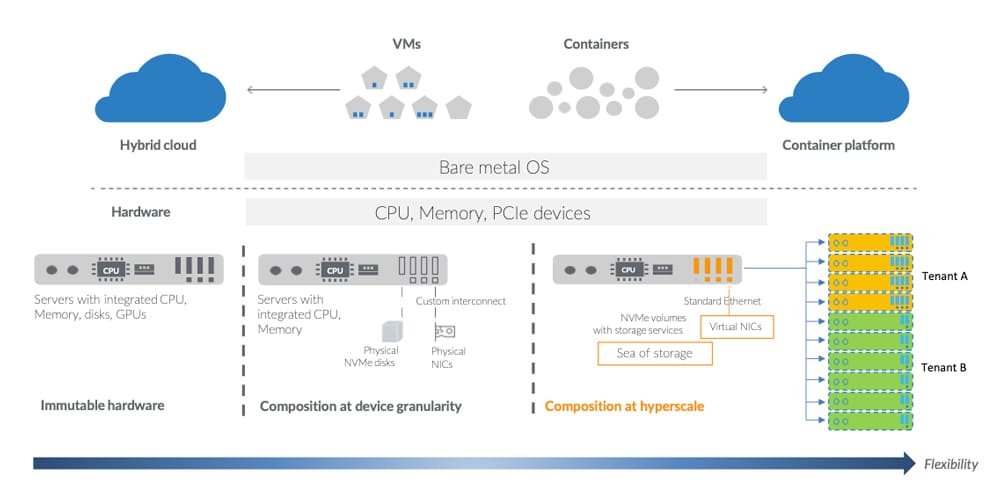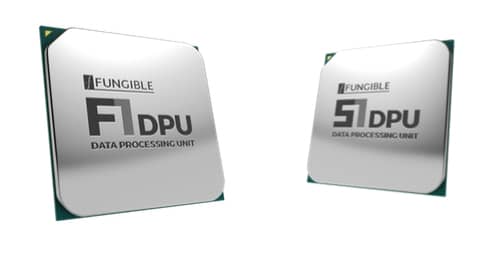Today Fungible announced what it is calling, the Fungible Data Center. This solution is said to be a comprehensive, turnkey that offers a multi-tenant, secure data center solution. The main thrust of the solution is to transform data centers from rigid, complex, and expensive silos into simple, highly efficient, and on-demand powerhouses. Fungible states that this has been their vision for years and now can deliver hyper-disaggregated, composable infrastructure that delivers bare-metal performance at the cost efficiencies and simplicity of hyperscale data centers.
Today Fungible announced what it is calling, the Fungible Data Center. This solution is said to be a comprehensive, turnkey that offers a multi-tenant, secure data center solution. The main thrust of the solution is to transform data centers from rigid, complex, and expensive silos into simple, highly efficient, and on-demand powerhouses. Fungible states that this has been their vision for years and now can deliver hyper-disaggregated, composable infrastructure that delivers bare-metal performance at the cost efficiencies and simplicity of hyperscale data centers.

The cloud has had an interesting and expedited evolution over the last few years. At first, it appeared to be a very large, inexpensive, slow, and “dumb” type of storage with some questionable security. Cloud service providers (CSPs) were able to prove out the security issue (though no media is fully secure) which made adoption much more attractive. Soon after several CSPs were able to show some pretty astonishing performance numbers on par with some on-prem deployments. At the same time, the cloud was moving beyond storage and offered several different applications making it ideal for those that needed to start or leverage several services but don’t want the upfront cost of on-prem deployment. The public cloud is great due to the above but not a fix-all. Several companies need a combination of both on-prem and public in a hybrid format.
This sounds like honey and roses but there are still limitations that cause issues. Absolute performance is needed at times but not always. In this case, overprovisioning and the costs associated, need to be built-in. On top of this, the cloud seems dynamic but the underlying infrastructure is not. It is rigid and immutable and lacks the flexibility to jump on new workloads and new security threats. This is where the Fungible Data Center enters the picture with the promise of transforming data centers from rigid, complex, and expensive silos to simple, highly efficient, and on-demand powerhouses.
Fungible Data Center
The Fungible Data Center aims to accomplished the above through a hyper-disaggregated, composable infrastructure paradigm. Sounds complicated, but the idea of composability has been around for a few years. Composable means that it takes disaggregated resources (servers, storage, networks, GPUs, FPGA accelerators) and leverages software to compose them into the needed resources in a few minutes. This has been attempted before and was seen as the next step beyond HCI, most notable by HPE (HP still at the time). Fungible also states that they can deliver bare-metal performance while fully utilizing all the available resources and preserving security postures across tenants, all of this in a turn-key solution.
The linchpin of the entire Fungible Data Center (or FDC) is the Fungible data processing unit (DPU) managed by the Fungible Data Center Composer (DCC) software. DPUs are fairly new pieces of technology (What’s the difference In CPUs, GPUs, and DPUs) though more and more companies are rolling out their version, most notably NVIDIA and Xilinx.
Fungible’s DPU unifies compute, storage, and networking by executes data-centric computations an order of magnitude more efficiently than general-purpose CPUs and facilitates highly efficient data interchange among server and storage nodes through its TrueFabric technology. Currently, the company has two DPUs the F1 and S1, the F1 being the higher performant DPU but the S1 is the core of the FDC.
Fungible Data Center Components
- Two or more Fungible FS1600 nodes. The FS1600 is a high-performance, secure, scale-out NVMe-oF storage platform. Two Fungible F1 DPUs power a single FS1600. The Fungible DPU enables the FS1600 to deliver unrivaled performance in the most demanding scenarios, featuring a random read rate of 15M IOPS (4KB), a throughput of 60 GB/s, and read latencies of +10μs vs. direct-attached storage (DAS) systems. The Fungible DPU hardware accelerators in FS1600 (including compression, erasure coding, encryption) operate at a line rate of 800 Gb/s. FS1600 addresses the constraints that have traditionally limited true storage disaggregation by delivering DAS-like performance, linearly scaled in large clusters.
- A set of compute servers with industry-standard processors, with no local disks, and one Fungible Data Services Platform (DSP) FC50/FC100/FC200 card. A Fungible S1 DPU powers each DSP card. The DSP card is a purpose-built fabric adapter, accelerating data center network, storage, and security performance while optimizing compute node application efficiency. Each DPU- enabled fabric adapter implements a separation of control and data plane, with a fully programmable data path optimized for all types of data-centric workloads.
- A set of three dedicated management nodes hosts the Fungible Data Center Composer, a comprehensive software solution that supports bare-metal data center composition, provisioning, management, and orchestration.
- A set of pre-qualified, industry-standard Top-of-Rack (ToR) switches for data and management networks and routers. For each rack, there is one ToR switch for the data network and one BMC management network. Each of the ToRs comes with DHCP relay capability, connecting to the data center spine network.
Another interesting facet of the FDC is the marriage of bare-metal performance and composability. By leveraging the Fungible DPU and DCC, bare-metal composition lets compute, storage, and network resources are consumed from an allocated pool of resources for specific application workloads. Bare-metal means no virtualization software or hypervisor but instead, the FDC uses standard drivers for Linux distributions. The DCC is said that allows users to manage bare-metal infrastructure like virtual machines through a single pane of glass.
The technology sounds very intriguing. Imagine cloud service providers and those running hybrid clouds being able to buy the Fungible Data Center and dynamically change it, again and again, depending on their needs at the time. While this won’t revolutionize IT, a large portion just won’t need to be this dynamic, it will definitively benefit a good segment.
Fungible Data Center Availability
The Fungible Data Center is available now. The company is also in strategic partnerships with key OEMs to deliver first-class worldwide deployment, support, and training.
Engage with StorageReview
Newsletter | YouTube | Podcast iTunes/Spotify | Instagram | Twitter | Facebook | RSS Feed



